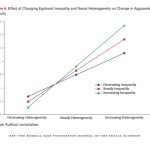“From Bad to Worse: How Changing Inequality in Nearby Areas Impacts Local Crime” is a new publication by Dr. Hipp and Dr. Kubrin in the special edition of The Russell Sage Foundation Journal of the Social Sciences on the Spatial Foundations of Inequality edited by George Galster & Patrick Sharkey. The paper combines innovative spatial methods, Egohoods, with a longitudinal approach to explore the relationship between spatial inequality and neighborhood crime rates.
Abstract:
 Recognition is growing that criminogenic neighborhood effects may not end at the borders of local communities, that neighborhoods are located relative to one another in ways that shape local crime rates. Inspired by this insight, this research explores the changing spatial distribution of race and income around a location and determines how such changes are associated with crime patterns and trends in neighborhoods in Los Angeles. We examine how changes from 2000 to 2010 in the income composition, racial composition, and intersection of these two constructs are linked with changes in levels of crime across local areas. We find that neighborhoods experiencing greater increases in spatial inequality in a broader area (two and a half miles around the neighborhood) experience greater increases in crime levels in the focal area over the decade, and that this pattern is strongest for neighborhoods simultaneously experiencing increasing average household income or increasing inequality. We also find that neighborhoods simultaneously experiencing increases in inequality and racial-ethnic heterogeneity experience increases in crime.
Recognition is growing that criminogenic neighborhood effects may not end at the borders of local communities, that neighborhoods are located relative to one another in ways that shape local crime rates. Inspired by this insight, this research explores the changing spatial distribution of race and income around a location and determines how such changes are associated with crime patterns and trends in neighborhoods in Los Angeles. We examine how changes from 2000 to 2010 in the income composition, racial composition, and intersection of these two constructs are linked with changes in levels of crime across local areas. We find that neighborhoods experiencing greater increases in spatial inequality in a broader area (two and a half miles around the neighborhood) experience greater increases in crime levels in the focal area over the decade, and that this pattern is strongest for neighborhoods simultaneously experiencing increasing average household income or increasing inequality. We also find that neighborhoods simultaneously experiencing increases in inequality and racial-ethnic heterogeneity experience increases in crime.
